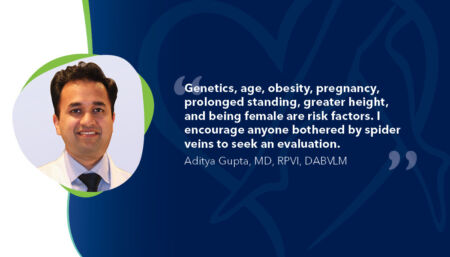
Are Spider Veins Supposed to Hurt?
Itching, burning, aching, and cramping sensations around spider veins are all signs that it may be time to treat your spider veins.

Smaller than varicose veins, these tiny, dilated, thread-like blood vessels do not bulge like varicose veins but can be just as unsightly and irritating.
Aditya Gupta, MD, RPVI, DABVLM, is the lead physician for Center for Vein Restoration (CVR) vein clinics in Austin, SW, Texas, and Austin, NW, Texas. Dr. Gupta is board-certified in Venous & Lymphatic Medicine, Physician Vascular Interpretation, and Internal Medicine.
He is an award-winning medical researcher passionate about bringing awareness of venous insufficiency, venous stasis, and lymphedema to the public.
Spider veins are tiny blue, purple, or green superficial veins. They are about 1mm to 3mm in diameter and are located within the skin (for reference, 1mm = just over 1/32 inch).
The most common cause is genetics. They are also more common in females (female hormones estrogen and progesterone are vasodilatory hormones (i.e., they widen the body's blood vessels), which leads to more spider veins.
Genetics is the most common cause of spider veins. Age is also a contributing factor. In fact, as we get older, everyone gets spider veins. Other risk factors include obesity, pregnancy, prolonged standing, greater height, and being female.
Spider veins are more common in females because of the female hormones that play an essential role in fertility and menstruation. Both estrogen and progesterone are naturally vasodilatory hormones that open blood vessels and lead to the dilatation of these superficial veins.
And, with each pregnancy, a woman can expect to develop more spider veins, given the higher levels of hormone and fluid volume changes during that period. After age 60, the incidence is almost the same in males and females.
No! Even though these veins are quite small, the tattooing process can lead to serious bleeding. One may actually require a trip to the emergency room due to the excess bleeding!
No, they are not. Spider veins cause three things: local pain, itching, and swelling (often at the end of the day). Otherwise, they are cosmetic and do not pose any harm.
No, they do not.
No. Spider veins can be present when a person has venous disease. However, one can have many spider veins without underlying vein disease or circulatory issues.
I encourage anyone bothered by spider veins to seek an evaluation by a board-certified vein specialist. We can evaluate your veins and recommend a course of treatment, such as visual sclerotherapy or foam sclerotherapy. Both procedures are office-based, non-surgical, and minimally invasive. Patients can immediately return to their usual routine with minimal downtime and few restrictions.
Best of all, eliminating unsightly spider veins reduces the physical symptoms of vein disease, including aching, itching, and fatigue.
To schedule with Dr. Gupta or any other highly-qualified CVR vein specialist, call 240-965-3915 or book via our online schedule.
Major insurance is accepted, including Medicare and Medicaid. If you don’t see your insurance listed? Reach out to us HERE.